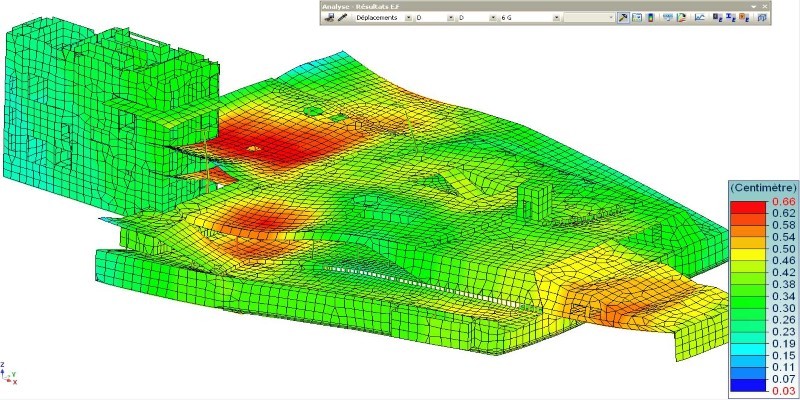
About Course
The finite Element Method (FEM) is one of the most popular numerical methods for boundary and initial value problems. One distinct feature of the Finite Element Method is that it can be generalized to the domains of any arbitrary geometry.
The theory of the Finite Element Method is developed on Variational methods. In this course, finite element formulations will be derived from the governing partial differential equation of different physical systems based on Variational methods.
It will start with one-dimensional Bar, Beam, Truss, Frame elements; and will be extended to two-dimensional structural and thermal problems. The framework of the standard master element in both 1D and 2D will be followed, so that transformation for any arbitrary geometry is well understood.
The two-dimensional formulation will be represented in the Tensorial framework, after building the necessary background in Tensor calculus. Most importantly for every element, the basic code for computer implementation will be provided and explained with step-by-step clarification. We will also elaborately present how to prepare a generalized Finite Element Method code with the first-hand implementation.
COURSE LAYOUT
Week 1:Part1: Variational Methods:
Functional and Minimization of Functional; Derivation of Euler Lagrange equation: (a) the First variation of Functional, (b) Delta operator Functional with (a) several dependent variables, (b) higher-order derivatives; Variational statement Weak Form); Variational statement to Minimization problemRelation between Strong form, Variational statement and Minimization problem; Different approximation methods with Computer Programming: Galerkin, method, Weighted Residual method; Rayleigh-Ritz method
Functional and Minimization of Functional; Derivation of Euler Lagrange equation: (a) the First variation of Functional, (b) Delta operator Functional with (a) several dependent variables, (b) higher-order derivatives; Variational statement Weak Form); Variational statement to Minimization problemRelation between Strong form, Variational statement and Minimization problem; Different approximation methods with Computer Programming: Galerkin, method, Weighted Residual method; Rayleigh-Ritz method
Week 2:Part 2. One dimensional Finite Element Analysis:
Gauss Quadrature integration rules with Computer Programming; Steps involved in Finite Element Analysis; Discrete system with linear springs; Continuous systems: Finite Element Method equation for a given differential equation Linear Element: Explaining Assembly, Solution, Post-processing with Computer Programming Quadratic element with Computer Programming: Finite element equation, Assembly, Solution, Post-processing; Comparison of Linear and Quadratic element
Gauss Quadrature integration rules with Computer Programming; Steps involved in Finite Element Analysis; Discrete system with linear springs; Continuous systems: Finite Element Method equation for a given differential equation Linear Element: Explaining Assembly, Solution, Post-processing with Computer Programming Quadratic element with Computer Programming: Finite element equation, Assembly, Solution, Post-processing; Comparison of Linear and Quadratic element
Week 3: Part 3. Structural Elements in One-dimensional Finite Element Method:
Bar Element with Computer Programming: Variational statement from governing differential equation; Finite element equation, Element matrices, Assembly, Solution, Post-processing; Numerical example of the conical bar under self-weight and axial point loads.Truss Element with Computer Programming: Orthogonal matrix, Element matrices, Assembly, Solution, Post-processing; Numerical example
Bar Element with Computer Programming: Variational statement from governing differential equation; Finite element equation, Element matrices, Assembly, Solution, Post-processing; Numerical example of the conical bar under self-weight and axial point loads.Truss Element with Computer Programming: Orthogonal matrix, Element matrices, Assembly, Solution, Post-processing; Numerical example
Week 4:Beam Formulation: Variational statement from governing differential equation; Boundary terms; Hermite shape functions for beam element with Computer Programming: Finite element equation, Element matrices, Assembly, Solution, Post-processing, Implementing arbitrary distributive load; Numerical example
Week 5:Frame Element with Computer Programming: Orthogonal matrix, Finite element equation; Element matrices, Assembly, Solution, Post-processing; Numerical example
Part 4. Generalized 1D Finite Element code in Computer Programming: Step by step generalization for any no. of elements, nodes, any order Gaussian quadrature; Generalization of Assembly using connectivity data; Generalization of loading and imposition of boundary condition; Generalization of Post-processing using connectivity data;
Part 4. Generalized 1D Finite Element code in Computer Programming: Step by step generalization for any no. of elements, nodes, any order Gaussian quadrature; Generalization of Assembly using connectivity data; Generalization of loading and imposition of boundary condition; Generalization of Post-processing using connectivity data;
Week 6:Part 5. Brief background of Tensor calculus: Indicial Notation: Summation convention, Kronecker delta and permutation symbol, epsilon-delta identity; Gradient, Divergence, Curl, Laplacian; Gauss-divergence theorem: different forms
Week 7 & 8: Part 6. Two-dimensional Scalar field problems:
2D Steady-State Heat Conduction Problem, obtaining weak-form, introduction to triangular and quadrilateral elements, deriving element stiffness matrix and force vector, incorporating different boundary conditions, numerical example. Computer implementation: obtaining connectivity and coordinate matrix, implementing numerical integration, obtaining global stiffness matrix and global force vector, incorporating boundary conditions, and finally post-processing.
2D Steady-State Heat Conduction Problem, obtaining weak-form, introduction to triangular and quadrilateral elements, deriving element stiffness matrix and force vector, incorporating different boundary conditions, numerical example. Computer implementation: obtaining connectivity and coordinate matrix, implementing numerical integration, obtaining global stiffness matrix and global force vector, incorporating boundary conditions, and finally post-processing.
Week 8 & 9:Part 7. Two-dimensional Vector field problems:
2D elasticity problem, obtaining the weak form, introduction to triangular and quadrilateral elements, deriving element stiffness matrix and force vector, incorporating different boundary conditions, numerical example. Iso-parametric, sub-parametric and super-parametric elements Computer implementation: a vivid layout of a generic code will be discussed Convergence, Adaptive meshing, Hanging nodes, Post-processing, Extension to three-dimensional problems Axisymmetric Problems: Formulation and numerical examples
2D elasticity problem, obtaining the weak form, introduction to triangular and quadrilateral elements, deriving element stiffness matrix and force vector, incorporating different boundary conditions, numerical example. Iso-parametric, sub-parametric and super-parametric elements Computer implementation: a vivid layout of a generic code will be discussed Convergence, Adaptive meshing, Hanging nodes, Post-processing, Extension to three-dimensional problems Axisymmetric Problems: Formulation and numerical examples
Week 10:Part 8. Eigenvalue problems
Axial vibration of the rod (1D), formulation and implementation Transverse vibration of beams (2D), formulation and implementation
Axial vibration of the rod (1D), formulation and implementation Transverse vibration of beams (2D), formulation and implementation
Week 11:Part 9. The transient problem in 1D & 2D Scalar Valued Problems
Transient heat transfer problems, discretization in time: method of lines and Rothe method, Formulation and Computer implementations
Transient heat transfer problems, discretization in time: method of lines and Rothe method, Formulation and Computer implementations
Week 12:Choice of solvers: Direct and iterative solvers
Finite Element Method INTENDED AUDIENCE: Final year Under Graduate Students, First-year Post Graduate Students
Course Content
Finite Element Method: Variational Methods to Computer Programming
-
Finite Element Method: Variational Methods to Computer Programming [Intro Video]
00:00 -
Lec 19: Gauss Divergence theorem and its application in Heat transfer and Structural analysis
00:00 -
Lec 20: Derivation of weak form of 2D steady-state heat conduction problem
00:00 -
Lec 21: Triangular element, calculating element stiffness and element force vector
00:00 -
Lec 22: Numerical example, assembly, mapping
00:00 -
Lec 23: Numerical integration, Neumann boundary, and higher order shape functions
00:00 -
Lec 24: Quadrilateral element, Lagrange shape functions, Serendipity elements
00:00 -
Lec 25: Development of a MATLAB code for solving 2D steady-state heat conduction problem
00:00 -
Lec 26: Demonstration of the MATLAB code
00:00 -
Lec 27: Elasticity problems in two dimension and obtaining the weak form
00:00 -
Lec 28: Deriving element stiffness matrix and element force vector, numerical example
00:00 -
Lec 29: Development of a MATLAB code for solving planar elasticity problems
00:00 -
Lec 30: Superconvergent Patch Recovery, error estimator, adaptive refinement
00:00 -
Lec 31: Solving eigenvalue problem in bar and beam, writing FEM code in MATLAB
00:00 -
Lec 32: Solving eigenvalue problem of membrane, writing FEM code in MATLAB
00:00 -
Lec 33:Solving transient problems (parabolic type)
00:00 -
Lec 34: Solving transient problems (hyperbolic type)
00:00 -
Lec 18: Second order tensor; Gradient, Divergence, Curl and Laplacian in Indicial notation
00:00 -
Lec 17: Indicial Notation: Summation convention, Kronecker delta, Permutation symbol
00:00 -
Lec 1: Functional, First variation, Euler Lagrange equation; Several Dependent variables
00:00 -
Lec 2: Functional with higher order derivatives; Variational statement
00:00 -
Lec 3: Differential equation, Variational statement and Minimization problem; Rayleigh-Ritz method
00:00 -
Lec 4: FEM steps: Explained with discrete linear springs; Gaussian Quadrature rule for integration
00:00 -
Lec 5: Solving one Ordinary Differential Equation using Linear Finite Element
00:00 -
Lec 6: Solving one Ordinary Differential Equation using Quadratic Finite Element
00:00 -
Lec 7: Bar Element: Elemental equation; Matlab Implementation with Example
00:00 -
Lec 8: Bar Element: Postprocessing; Comparison with Analytical Solution; Bar with linear springs
00:00 -
Lec 9: Truss Element: Elemental equation; Matlab Implementation with Example
00:00 -
Lec 10: Beam Element: Variational statement; Hermite shape function
00:00 -
Lec 11: Beam Element: Elemental equation; Matlab implementation with Example
00:00 -
Lec 12: Beam Element: Matlab implementation for the example with Non-uniform distributed load
00:00 -
Lec 13: Frame Element: Derivation of elemental equation in global reference frame
00:00 -
Lec 14: Frame Element: Matlab implementation with one Example
00:00 -
Lec 15: Generalization of Geometry data; Stiffness matrix, Load vector formation at element level
00:00 -
Lec 16: Generalization of Assembly, Imposition of Boundary condition and Load information
00:00 -
Lec 35: Solving elasticity problems in 3D using FEM, Solvers
00:00
Student Ratings & Reviews

No Review Yet
